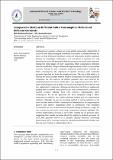| dc.description.abstract | Contemporary garment enterprises must exhibit remarkable adaptability to
create diverse styles and types of clothing in response to market demands for
their survival. Enhanced excellence across all dimensions justifies optimum
pricing. In competitive marketplace, cost calculation of garment not only
optimum for net profit generation but also necessary to avoid order rejection.
During the initial stages of order acquisition, fabric consumption estimates
must be established using mathematical approximations before actual marker
creation. Among the two commonly employed mathematical methods for
fabric consumption, the alignment of specific formulas with particular
garment types has not been thoroughly analyzed. The aim of this study is to
identify the most accurate method of fabric consumption for various garment
categories. For this purpose, six distinct garments have been selected for
experimentation: two woven shirts (short and long sleeves) and four knit Tshirts (including two set-in sleeve variations with long and short sleeves, and
two raglan sleeve variations with long and short sleeves). Pattern making and
grading were executed using specification sheet measurements, followed by
marker creation utilizing Boke CAD software. Subsequently, fabric
consumption for all six garments has been compared using 3 fabric
consumption methods: one marker planning method and two mathematical
methods. Although the marker planning method is well-established as the
most accurate means of fabric consumption determination, its usage requires
pattern and marker preparation prior to production. This limitation
necessitates the use of mathematical formulas during preliminary stages for
cost calculations and order processing. Comparative analysis highlights that
neither mathematical formula is universally suitable for all garment types,
suggesting that specific formulas should be applied to distinct garments. As
such, this guideline serves as a valuable industry resource, preventing
unnecessary fabric wastage caused by misusing mathematical formulas and
thereby contributing to sustainability efforts. | en_US |

